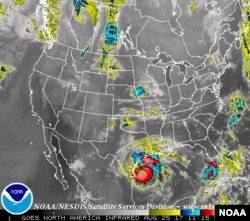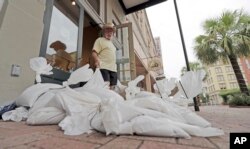Hurricane Harvey strengthened to a Category 4 storm Friday evening shortly before the eye of the storm hit the Texas coast, with forecasters calling it a "life-threatening storm."
The National Hurricane Center in Miami said Harvey had sustained winds of over 125 mph (200 kph).
Latest from the National Hurricane Center:
Texas Governor Greg Abbott said the hurricane would be a "major disaster" and warned residents to prepare for record flooding. He said he had issued a request for a federal disaster declaration.
President Donald Trump tweeted late Friday that he had officially declared a disaster in Texas, clearing the way for federal assistance.
The storm was just east of Corpus Christi and was expected to hit a 375-mile (600-kilometer) stretch of Texas coastline during the night.
Storm surge
The National Hurricane Center said tide gauges off the coast of Texas indicated that the storm surge was already occurring near Corpus Christi and Port Aransas. It said weather conditions were deteriorating along the coast and winds were already blowing with tropical storm force.
The head of the U.S. Federal Emergency Management Agency on Friday warned of a "very significant disaster" about to hit Texas.
FEMA Director Brock Long, speaking on CNN, said his biggest concern was that some citizens along the coastline had ignored warnings from officials and had chosen not to evacuate their homes.
"If they have not, their window to evacuate is rapidly coming to a close," Long said. "Storm surge has the highest potential to kill the most amount of people and cause the most damage. On top of that, we are looking at a significant inland flood event over many counties."
Long, along with acting Department of Homeland Security Secretary Elaine Duke, briefed President Donald Trump on Friday morning on preparations for the storm. Trump said on Twitter he was "closely monitoring" the storm, and he spoke with the governors of Texas and Louisiana to ensure them the federal government would be there to assist as needed.
The mayor of the Texas Gulf Coast city of Galveston, James Yarbrough, said Friday that the hurricane was expected to flood downtown streets, and that the water might not recede for three or four days.
"We've all been through a number of these. This one's a little different. ... This one's not going anywhere," he said.
Hurricanes usually weaken rapidly once they move inland, but forecasters said this storm would follow an unusual pattern — stalling once it hits the coast, then probably moving back out to sea briefly and making a second drenching pass at low-lying coastal communities.
Harvey was expected to pour nearly 40 inches (100 centimeters) of rain over a wide area of the Texas coast during the next three days.
The National Hurricane Center said "life-threatening" floods should be expected, along with storm surges of more than 10 feet (3 meters). It said any preparations for the storm not already in place "should be rushed to completion."
Brad Kieserman, vice president for disaster operations at the American Red Cross, told VOA, "I expect we are going to see major flood stage on probably every major river in the lower half of Texas.
"That is going to destroy homes, it is going to destroy businesses, it is going to render many homes to be uninhabitable. And I think you are going to see many of those rivers stay at major flood stage well past Labor Day," Kieserman said.
Preparing for flooding
Texans who live on the Gulf Coast prepared for the storm with stacks of sandbags around particularly flood-prone areas. Residents crowded stores to buy water and other supplies to sustain them during what could be days of turmoil.
Federal courts in southern Texas began closing, while federal courts in other parts of the state and in neighboring Louisiana said they were monitoring weather developments.
The last hurricane to hit the southern portion of the Texas coast struck 14 years ago.
Abbott ordered state emergency workers to mobilize for any necessary search-and-rescue operations. He preemptively declared a state of disaster in 30 counties on or near the coast to speed deployment of state resources.
VOA's Sarah Williams contributed to this report.














